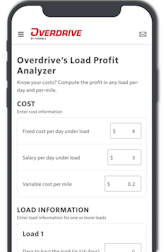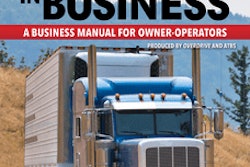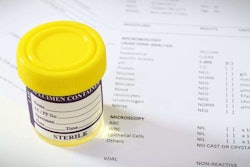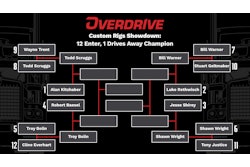Canfield, Ohio, owner-operator Earl Evans uses Form 129-F from J.J. Keller to record every maintenance procedure he performs on his truck. Evans keeps the form inside a briefcase in his truck, with a copy of every work order, done under warranty or not. “I do this because you need to have everything documented,” Evans says. “What if a transmission is warranted for one year and fails in 11 1/2 months? You need to be able to prove your warranty is still in effect.”
If he even does a repair on the road, he records it right away. “You think you can remember, but you can’t,” Evans says.
Savvy truckers such as Evans know that sticking to a service schedule is nearly as important as the maintenance itself. That means reading and studying the owner’s manuals, keeping track of when everything needs doing and noting what was done when.
Mark Ehlers, serviceability manager at International, suggests using a computer software maintenance tool or a Microsoft Excel spreadsheet. If you absolutely hate record keeping, you can write the date, hours and miles when a filter was replaced or the engine oil changed right on the filter or engine, using a permanent marker and weatherproof tag.
If you’re having trouble keeping track of more than one truck, Tom Tahaney, New England district service manager for Kenworth, suggests using the services of Arsenault and Associates. Arsenault’s services are designed to be appropriate for small fleets and giants of the industry.

Monty Cook, service manager at Kenworth of Tennessee, suggests Kenworth’s Premier Care system. You establish operating patterns in miles or hours per month and give the details to your dealer. The dealer notifies you when the service is required and helps you schedule an appointment at a dealer nearby if you are away from home. All the original equipment manufacturers offer such programs.
Nick and Dee’s Trucking, a 10-vehicle fleet in Hereford, Texas, uses the Cummins Road Relay in-dash system to alert drivers that maintenance draws near. “We keep inspection reports for our vehicles’ daily pretrip and other in-house inspections, which include a description of any problem found and the action taken to repair it,” says Bob Maddox of Nick and Dee’s. “Many owner-operators seem to have forgotten that this is a DOT requirement.”
Tom Tahaney asks, “Are you leased to a good carrier with a solid maintenance program? You might want to just adopt their maintenance schedule.” You might even be able to get the maintenance on your tractor and their trailer in sync.
Experts underscore the value of studying and learning from the owner’s manual, a highly detailed review of maintenance requirements. Tahaney says the same attention should also be given to the engine and drivetrain manuals. If your trucks run in an extreme application, you may want to tighten up on service intervals.
Should you do it yourself?
“I believe you can do your own basic maintenance, like changing your oil and filters and greasing the truck,” says Gordon Bow of Oakfield, N.Y. “But to do more complex jobs, you need to have the right tools, a good facility and the proper knowledge of details such as torque specs, lashes and other clearance measurements.”
Bow has done a lot of heavy work and routinely does complete brake jobs on his tractor and trailer, right down to replacing camshaft bushings. But he takes his Cat 3406E to the dealer for setting the electronic injectors and other overhead work.
Evans says you need an adequate facility and the right tools and knowledge to do your own work. He often picks up component manuals, complete with part numbers, at trade shows.
Ehlers recommends getting a detailed look at factory service literature as the first step in exploring any major maintenance job. Major component service information is frequently available on the manufacturer’s website.
Remanufactured components offer ideal cost/benefit ratios because “they’re brought up to new specs, and they have a warranty,” Tahaney says. “Nobody rebuilds slack adjusters themselves any more.”
Al Hertzog, service training manager at Mack Trucks, recommends Mack owners attend Mack’s factory schools. The $100 a day cost includes your copies of the manuals, and you may get some courses included with the price of a new truck. Hertzog says the schools “teach owner-operators what they can handle and what they can’t. And, if you do decide to perform the work, you won’t be performing like a shade-tree mechanic. Our owner-operator and fleet customers are trained in the same classes as our dealer technicians.”
If you lack the knowledge, tools or the facility to do the job, farm it out, Bow says. “If you have to tear it down a second time, that means an awful lot of downtime.”
Farming out the routine
Many owner-operators and small fleets take their trucks to a local dealer or other service outlet for all service. Tahaney says, “The big advantage is you don’t have to worry about disposal of used oil and filters. Also, many times they can do the work a lot faster than you can, which will reduce your downtime. All the truck OEMs have quick-lube services at their dealers.”
He suggests you check on the quality of filters and oil used to make sure you’re getting the best. Find out whether the technicians follow factory recommendations on procedures such as jacking up the chassis to lube kingpins.
Can you save money and time under the truck by specifying and using reduced maintenance items and fluids? Of course. “But,” Hertzog says, “while extended service items do work, you can always get one that develops trouble. Don’t take an item like a self-adjusting clutch for granted but inspect it at the specified interval. Is it still adjusting?”
“Use synthetic fluids for extended service intervals, but don’t forget about the component,” Ehlers says. “A wise maintainer will still routinely check the fluid level, inspect the color and odor and look for signs of contamination and overheating. Long-life coolants still need to be routinely checked for freeze protection and signs of oil or fuel contamination.”
Regardless of how you handle your truck’s maintenance, make sure you keep track of service intervals and insist on using quality parts. When you depend on technicians, make sure they are qualified, know factory service procedures and inspect the vehicle carefully.
This form 129-F, Vehicle Maintenance File, from J.J. Keller and Associates, can be used to keep track of all your maintenance work by date and mileage.
Typical OEM schedules for line-haul trucks
Daily
Check all fluid levels and look for fluid and air leaks, tire wear, and other essentials of the pretrip inspection. Drain air tanks and fuel filters. Except in very humid weather, large amounts of water in air tanks indicates a need for air dryer service.
15,000-25,000 miles
50,000-100,000 miles or one year
This chart of Volvo VN chassis lube items shows where lubricants need to be checked or replaced.
How much will it set me back?
For many reasons, prices for basic maintenance services can vary widely, so it pays to ask around and see what going rates are.
Midway Truck Service, a Western Star dealer in Bethel, Pa., charges $50 per hour for labor and refuses to set a price even for a basic service, charging for the time taken to do the job right. About the only standard price it offers is a Pennsylvania state safety inspection for one hour’s labor.
Monty Cook, service manager at Kenworth of Tennessee, says that even if you do most routine maintenance yourself, it can pay to take a vehicle to the dealer occasionally just to get a second opinion. “We will give you a list of everything we’ve found that needs attention,” he says. He says a local fleet brought in an otherwise well-maintained vehicle. The dealer found the exhaust system was leaking because of some bad clamps. They were repaired under warranty at no cost to the fleet.
Kenworth of Tennessee offers an express lube service and 26-point basic safety inspection for $140. An S-Service includes a 75-point safety inspection and services such as adjusting tire pressure and measuring and reporting brake lining thickness. It costs about $200. A C-service qualifies as a federal Department of Transportation safety inspection and includes 147 items. The five-hour procedure costs about $350.
As you compare service costs, be sure to check the quality of parts and the experience of the technicians.








